Defining the roles of cis-acting RNA elements in tombusvirus replicase assembly in vitro
- PMID: 22013057
- PMCID: PMC3255868
- DOI: 10.1128/JVI.00404-11
Defining the roles of cis-acting RNA elements in tombusvirus replicase assembly in vitro
Abstract
In addition to its central role as a template for replication and translation, the viral plus-strand RNA genome also has nontemplate functions, such as recruitment to the site of replication and assembly of the viral replicase, activities that are mediated by cis-acting RNA elements within viral genomes. Two noncontiguous RNA elements, RII(+)-SL (located internally in the tombusvirus genome) and RIV (located at the 3'-terminus), are involved in template recruitment into replication and replicase assembly; however, the importance of each of these RNA elements for these two distinct functions is not fully elucidated. We used an in vitro replicase assembly assay based on yeast cell extract and purified recombinant tombusvirus replication proteins to show that RII(+)-SL, in addition to its known requirement for recruitment of the plus-strand RNA into replication, is also necessary for assembly of an active viral replicase complex. Additional studies using a novel two-component RNA system revealed that the recruitment function of RII(+)-SL can be provided in trans by a separate RNA and that the replication silencer element, located within RIV, defines the template that is used for initiation of minus-strand synthesis. Collectively, this work has revealed new functions for tombusvirus cis-acting RNA elements and provided insights into the pioneering round of minus-strand synthesis.
Figures
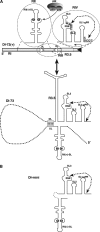

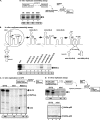

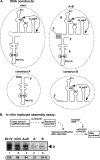
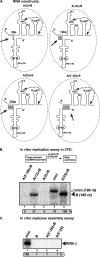
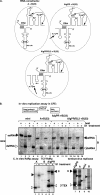
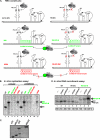
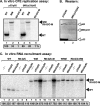

Similar articles
-
Conserved motifs in a tombusvirus polymerase modulate genome replication, subgenomic transcription, and amplification of defective interfering RNAs.J Virol. 2015 Mar;89(6):3236-46. doi: 10.1128/JVI.03378-14. Epub 2015 Jan 7. J Virol. 2015. PMID: 25568204 Free PMC article.
-
Role of an internal and two 3'-terminal RNA elements in assembly of tombusvirus replicase.J Virol. 2005 Aug;79(16):10608-18. doi: 10.1128/JVI.79.16.10608-10618.2005. J Virol. 2005. PMID: 16051853 Free PMC article.
-
Translation elongation factor 1A is a component of the tombusvirus replicase complex and affects the stability of the p33 replication co-factor.Virology. 2009 Mar 1;385(1):245-60. doi: 10.1016/j.virol.2008.11.041. Epub 2009 Jan 7. Virology. 2009. PMID: 19131084 Free PMC article.
-
Non-template functions of the viral RNA in plant RNA virus replication.Curr Opin Virol. 2011 Nov;1(5):332-8. doi: 10.1016/j.coviro.2011.09.011. Epub 2011 Oct 22. Curr Opin Virol. 2011. PMID: 22440835 Review.
-
Yeast as a model host to dissect functions of viral and host factors in tombusvirus replication.Virology. 2006 Jan 5;344(1):211-20. doi: 10.1016/j.virol.2005.09.017. Virology. 2006. PMID: 16364751 Review.
Cited by
-
Authentic in vitro replication of two tombusviruses in isolated mitochondrial and endoplasmic reticulum membranes.J Virol. 2012 Dec;86(23):12779-94. doi: 10.1128/JVI.00973-12. Epub 2012 Sep 12. J Virol. 2012. PMID: 22973028 Free PMC article.
-
Intragenomic Long-Distance RNA-RNA Interactions in Plus-Strand RNA Plant Viruses.Front Microbiol. 2018 Apr 4;9:529. doi: 10.3389/fmicb.2018.00529. eCollection 2018. Front Microbiol. 2018. PMID: 29670583 Free PMC article. Review.
-
Functional long-range RNA-RNA interactions in positive-strand RNA viruses.Nat Rev Microbiol. 2014 Jul;12(7):493-504. doi: 10.1038/nrmicro3288. Nat Rev Microbiol. 2014. PMID: 24931042 Free PMC article. Review.
-
Differential roles of Hsp70 and Hsp90 in the assembly of the replicase complex of a positive-strand RNA plant virus.J Virol. 2012 Nov;86(22):12091-104. doi: 10.1128/JVI.01659-12. Epub 2012 Aug 29. J Virol. 2012. PMID: 22933272 Free PMC article.
-
The resistance protein Tm-1 inhibits formation of a Tomato mosaic virus replication protein-host membrane protein complex.J Virol. 2013 Jul;87(14):7933-9. doi: 10.1128/JVI.00743-13. Epub 2013 May 8. J Virol. 2013. PMID: 23658455 Free PMC article.
References
-
- An M, et al. 2010. A Y-shaped RNA structure in the 3′ untranslated region together with the trans-activator and core promoter of Red clover necrotic mosaic virus RNA2 is required for its negative-strand RNA synthesis. Virology 405:100–109 - PubMed
-
- Bertrand E, et al. 1998. Localization of ASH1 mRNA particles in living yeast. Mol. Cell 2:437–445 - PubMed
-
- den Boon JA, Ahlquist P. 2010. Organelle-like membrane compartmentalization of positive-strand RNA virus replication factories. Annu. Rev. Microbiol. 64:241–256 - PubMed
Publication types
MeSH terms
Substances
Grants and funding
LinkOut - more resources
Full Text Sources

